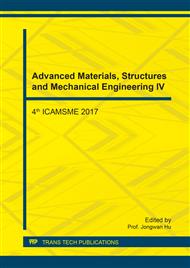p.42
p.48
p.54
p.60
p.65
p.71
p.83
p.89
p.95
Effects of Sintering Temperature on the Mullite-Based Ceramics Fabricated from Rice Husk Ash
Abstract:
Mullite-based ceramics were prepared by utilizing agriculture by-product called as rice husk ash (RHA) from untreated rice husk (RH) and commercial alumina powdermixtures. Various samples were prepared accordingly with the mullite stoichiometric composition and subjected to the uniaxial hydraulic press. The green bodies, then were sintered to various temperatures at 1200 °C, 1300 °C, 1350 °C, 1400 °C, 1450 °C and 1500 °C in an electric furnace. Physical and microstructural characterization were done such as bulk density (BD), linear shrinkage (LS), X-ray fluorescence (XRF), X-ray diffraction (XRD) and field emission scanning electron microscope (FESEM). The sample M1, which composed the slightest RHA (40 %) was considered the optimum composition which produced the highest densification, 3.101 g/cm3 and the lowest linear shrinkage, 8.62 % which compareswith the theoretical mullite density. Besides, it is supported by the evidence of the presenceof mullite in the samples sintered 1300 °C (shown as elongated shape) as primary mullite and continued to grow at higher temperatures at 1400 °C (shown as equiaxed shape) as secondary mullite. The sintered samples showno evidence of mullite inearly at 1200 °C due to insufficient energy to diffuse for mullitization. As the sintering temperature increased, mullitization increased while decreasing the distribution of glassy phase and voids. The results revealed the high dependency of bulk density and linear shrinkage on the Al2O3 content and the values were gradually increased with the increase of sintering temperature. These findingsmay lead to the extended study ofthermal insulationmaterials as mullite ceramic is an excellent candidate for this application due to its properties.
Info:
Periodical:
Pages:
65-70
Citation:
Online since:
November 2017
Price:
Сopyright:
© 2017 Trans Tech Publications Ltd. All Rights Reserved
Share:
Citation:


